Tour packages are beneficial for both travellers and tour operators:
- They help travellers simplify vacation planning (especially in new destinations where they don’t know the best things to book and want curated experiences). Travellers can look for packages that cover various aspects of their planning, such as accommodations, activities, and transportation, and fill their day-to-day schedules.
- They enable tour operators to diversify their product lines, stand out from the competition, attract a broader audience, win new customers, and earn more revenue from each booking. Ultimately, most business owners find that offering tour packages can be an effective way to drive growth.
We’ve been working with tour operators for over 10 years, helping them grow their businesses through partnerships, online travel agencies (OTAs), and other marketing strategies. So, our team created this guide with tips to help you create tour packages that entice travellers and earn you business.
Our tour operator software, Bókun, offers user-friendly tools to create detailed tour packages, partner with other businesses in the tourism industry, and simplify booking management.
If you’re interested in exploring our solution, keep reading or start a free 14-day trial.
How to determine the best packages to offer
The first steps to begin brainstorming here include:
- Researching existing tour packages. See what others provide and what’s popular to do in your area.
It’s helpful to check OTAs (such as Viator, GetYourGuide, Expedia, Tiqets, and Booking.com) and take note of what’s trending on those platforms. Then, of course, you should browse Google and major competitors’ websites to see what’s listed.
- Considering different target markets. Families with kids, solo travellers, couples or honeymooners, seniors or retirees, bachelor or bachelorette groups, and more.
- Understanding customers’ interests and preferences. Now, there could be a lot of options here, so you should consider this for each customer group outlined above. What would be best for a family? A solo traveller? Honeymooners? And so on. We suggest creating a list of customer groups and adding potential activities below each one.
- Accounting for traveller budgets. Think about average costs for travel plans in your area and strategically price your packages to offer customers a better value, without taking losses on your end.
- Evaluating your product line and honing in on your unique selling points. Are there opportunities to create tour packages from existing offerings? If you want to build more comprehensive packages, what types of partners would you need to connect with?
- Looking at your previous customer reviews and social media/email enquiries. See if customers have suggested or requested packages. You could have ideas right at your fingertips.
Another simple way to approach this is by thinking about the types of packages you’ve always dreamed of providing. You can also put yourself in a traveller’s shoes and think about what would be most appealing to you.
And remember — you aren’t limited to just one package. You can — and should — plan to offer a variety of packages. This helps you appeal to various customer groups, interests, and budgets, and it allows you to gather insights on what is booked most frequently. You may find one or two packages are booked significantly more often than others. Then you can use those findings to tweak your packages or add new ones.
For example, you could offer…
- A Sights of Rome package, including tours of the Colosseum, Pantheon, Sistine Chapel, and other noteworthy attractions.
- A Switzerland with Kids family-centric, multi-day travel experience, with tours of must-see attractions, dining at popular kid-friendly restaurants, and the customers’ hotel stay.
- A Newlywed Getaway through Italy, with catamaran charters, wine tours, and a resort stay.
Competitor research & learning about what other providers offer
Now, let’s dive deeper into that first bullet and show you how to conduct competitor analysis.
Let’s say we’re a tour operator based in Dubai and we want to learn about the different types of tour packages competitors offer. We could start with a basic search of “Dubai tour packages” on Viator to see the most popular options:
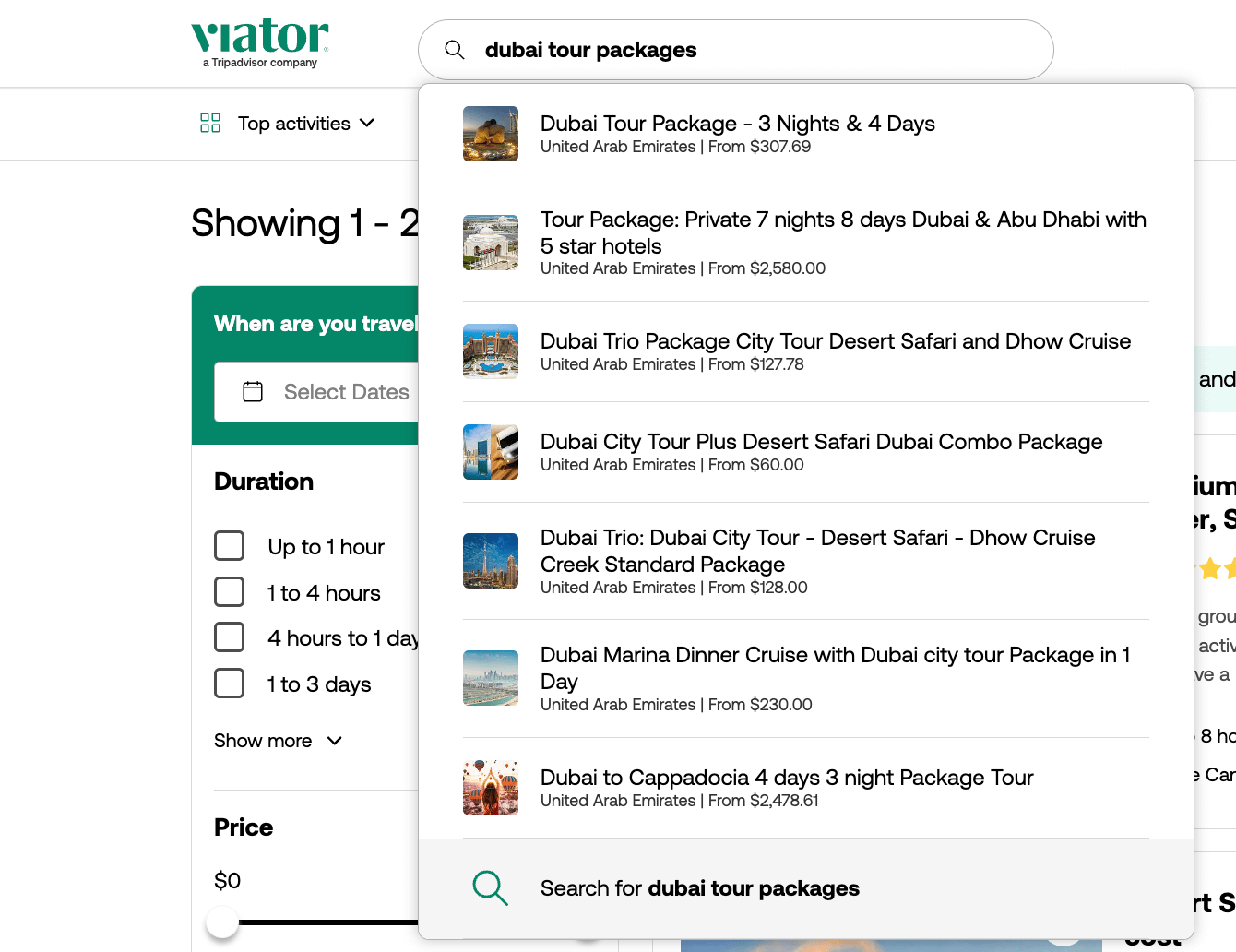
Then, we can view the list of results and use Viator’s filtering options to find tours based on pricing, reviews, or other requirements.
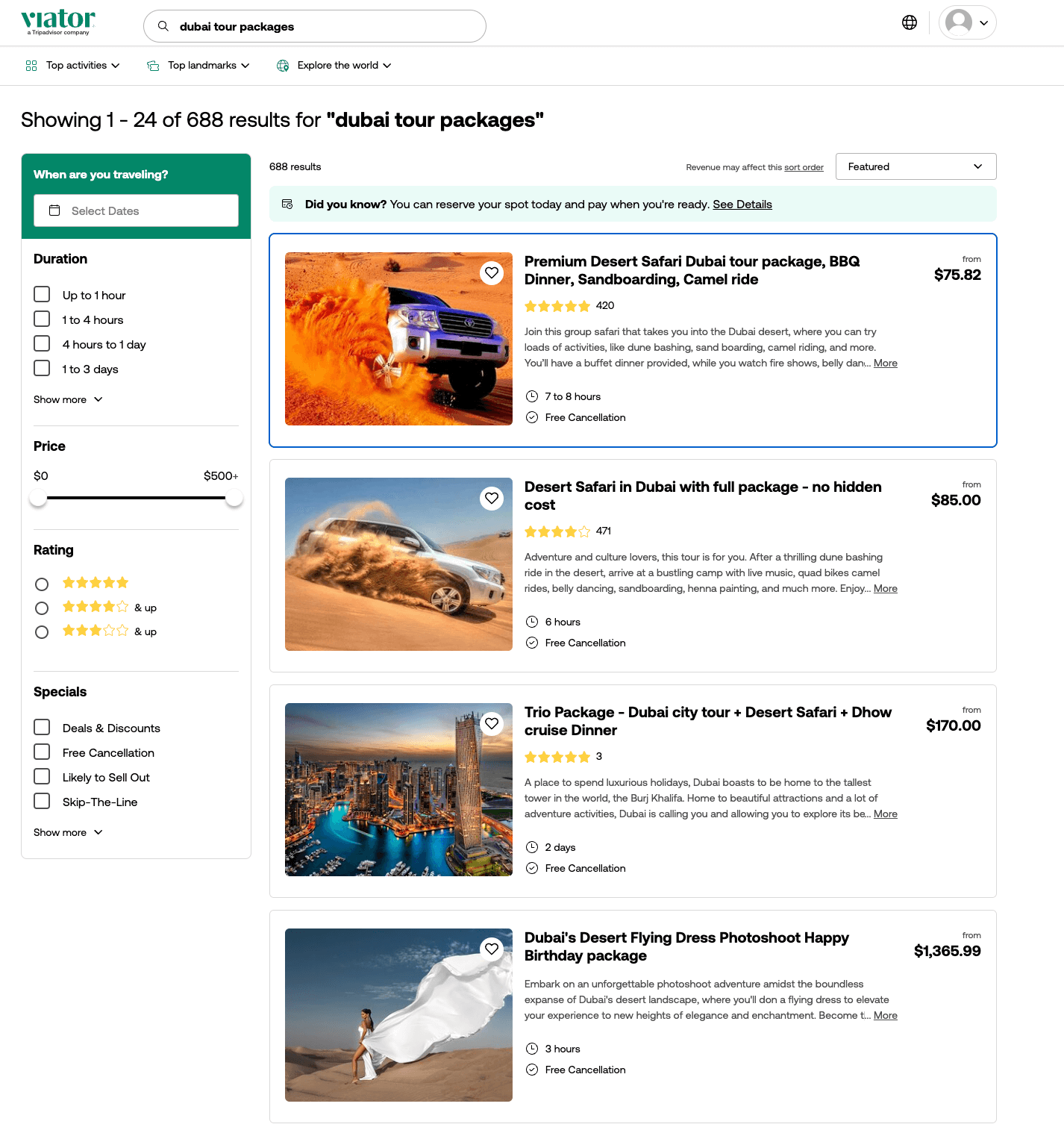
Alternatively, we could check Google with a simple search of “tour packages in Dubai” to see what others would see when doing this research.
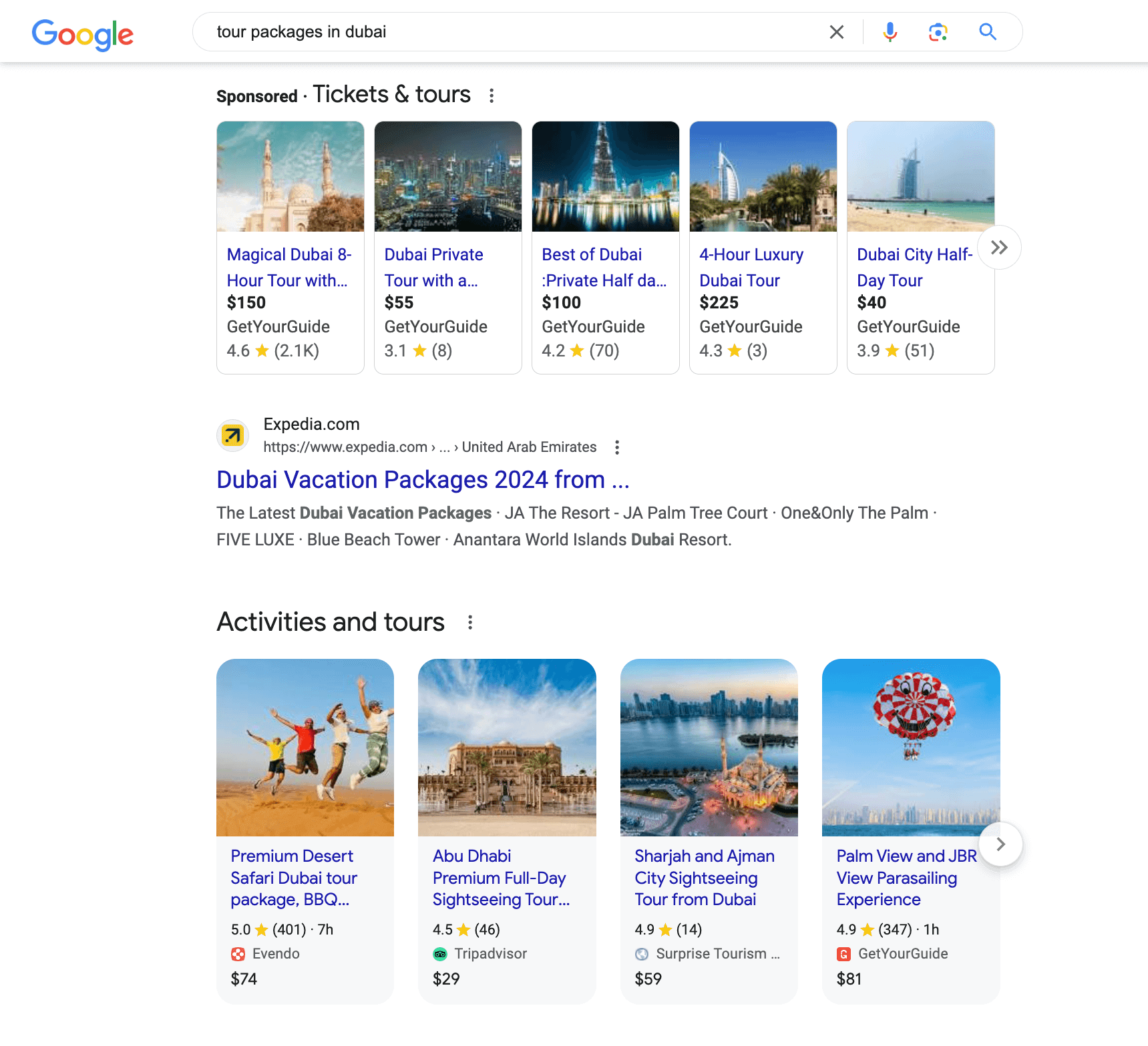
Notice that most tour operators offer single-day experiences that combine tours and activities. We only see a few overnight or multi-day experiences. So again, you don’t need the “entire package” to offer tour packages.
This research provides an overview of what’s already out there, popular travel preferences, and insights into which products and services to include in tour packages — offering some guidance on how to develop these packages.
Understanding your target audiences & markets
Now, research on these next points will primarily come from customer reviews.
We suggest looking at reviews of the popular experiences listed on OTAs, Google, and competitor websites to gauge the types of travellers booking these experiences.
Are you noticing feedback from families or couples? Do reviews mention group trips, such as bachelor or bachelorette parties, or corporate retreats?
You can even check out reviewers’ profiles to learn more about them and see the other types of experiences they’ve reviewed.
This provides insight into the types of packages that attract each customer group.
Leaning into customer interests & preferences
To learn about interests and preferences, pay attention to the details in reviews.
What do customers say they like about experiences? Do they mention that they were looking for something in particular (a certain activity or a package that combined specific areas of travel)?
On the flip side, do reviews mention any critical feedback or suggest what they didn’t like about experiences?
These findings are going to tell you where you can improve upon what’s already offered. You can see exactly what travellers like or dislike and identify opportunities to outperform competitors.
Accounting for traveller budgets
To understand budgets and pricing strategies, take note of the prices for existing packages and look for reviews that mention savings or splurging.
What are customers saying about package pricing? Do they believe packages offer a good value, allowing them to do more without spending a fortune? Or did they spend more than they would have liked to?
You should also consider the general costs of vacationing in your area. What rates are hotels, resorts, or BnBs charging? What are travellers paying for transportation around your area? How much are travellers paying for a typical lunch or dinner around town?
If customers are spending a pretty penny just to vacation in your town, they may prefer (or require) more affordable activities. But if there is a way for you to combine your activities with another travel provider’s services, you could score them a deal and more easily win their business.
Overall, you should be cognizant of traveller costs to determine where your services fit into their budgets and how you can offer reasonable pricing.
Evaluate your product line & determine your unique selling points
Now that you understand what competitors are doing and what customers are looking for, it’s time to turn your attention to your tour experiences. Think about your differentiators and what makes you unique:
- Do you have specialised expertise or credentials? For example, a certified sommelier leading wine tours, a marine biologist on wildlife excursions, or a historian with a PhD guiding heritage walks.
- Do you offer behind-the-scenes or after-hours access? Private museum viewings, kitchen tours with chefs, or sunset access to normally closed venues.
- Do you have insider local knowledge or connections? Family-run business with generations of local history, relationships with artisans and craftspeople, or access to hidden gems that tourists rarely see.
- Do you cater to niche interests or special needs? Photography-focused tours with ideal timing and locations, accessibility accommodations beyond the standard, or kid-friendly adventure experiences.
- Do you provide unique transportation or equipment? Vintage vehicles, luxury yachts, or specialised gear that competitors don’t offer.
- Are your group sizes uniquely small or personalised? Intimate groups of 6 or less (when competitors take 20 plus people), one-on-one experiences, or custom-tailored itineraries.
- Do you have exclusive partnerships or sponsorships? Official partnerships with conservation organisations, collaborations with Michelin-starred restaurants, or relationships with private estates or vineyards.
Once you’ve identified your differentiators, think about how to build packages around those strengths. Can you combine your existing tours in ways that amplify what makes you unique? Or do you need partners to create a more comprehensive experience?
The key is being strategic: lean into what sets you apart, look for natural combinations within your current offerings, and pursue partnerships when they genuinely enhance packages.
Pull nuggets from your customer reviews
You can also identify your strengths (and weaknesses) by digging into customer reviews of your tours.
What do customers say they like most about their time with you? Do they suggest any areas for improvement? Or, as mentioned earlier, do they provide suggestions on other types of experiences they’d like to pair with your tours?
Look for patterns amongst reviews to identify what you should double down on and where you can improve.
How to design attention-grabbing tour packages
We suggest creating tour packages on both your website and on OTAs like Viator. This makes booking easier for customers, as they can find your packages on multiple sites and book where it’s most convenient, and it allows you to promote your experiences across various platforms.
Here’s what customers typically look for in these listings:
- What experiences or services are included (and if there are options to customise the experience or purchase add-ons)
- Detailed itineraries for each experience, along with important notes about activities, accommodations, and transportation
- Pricing — overall, and by service; some travellers buy packages because they can receive discounts for booking bundles, so it’s good to show list prices with the discounted rates
- Duration (if it’s a single or multi-day experience)
- Typical age range for guests (or which audience the package is tailored to — couples, families, etc.)
- Minimum and maximum capacities for packages
- Cancellation policies
- The ability to instantly check availability, purchase, and edit bookings
For example, let’s click into the Premium Desert Safari Dubai tour package that we saw on Viator earlier:
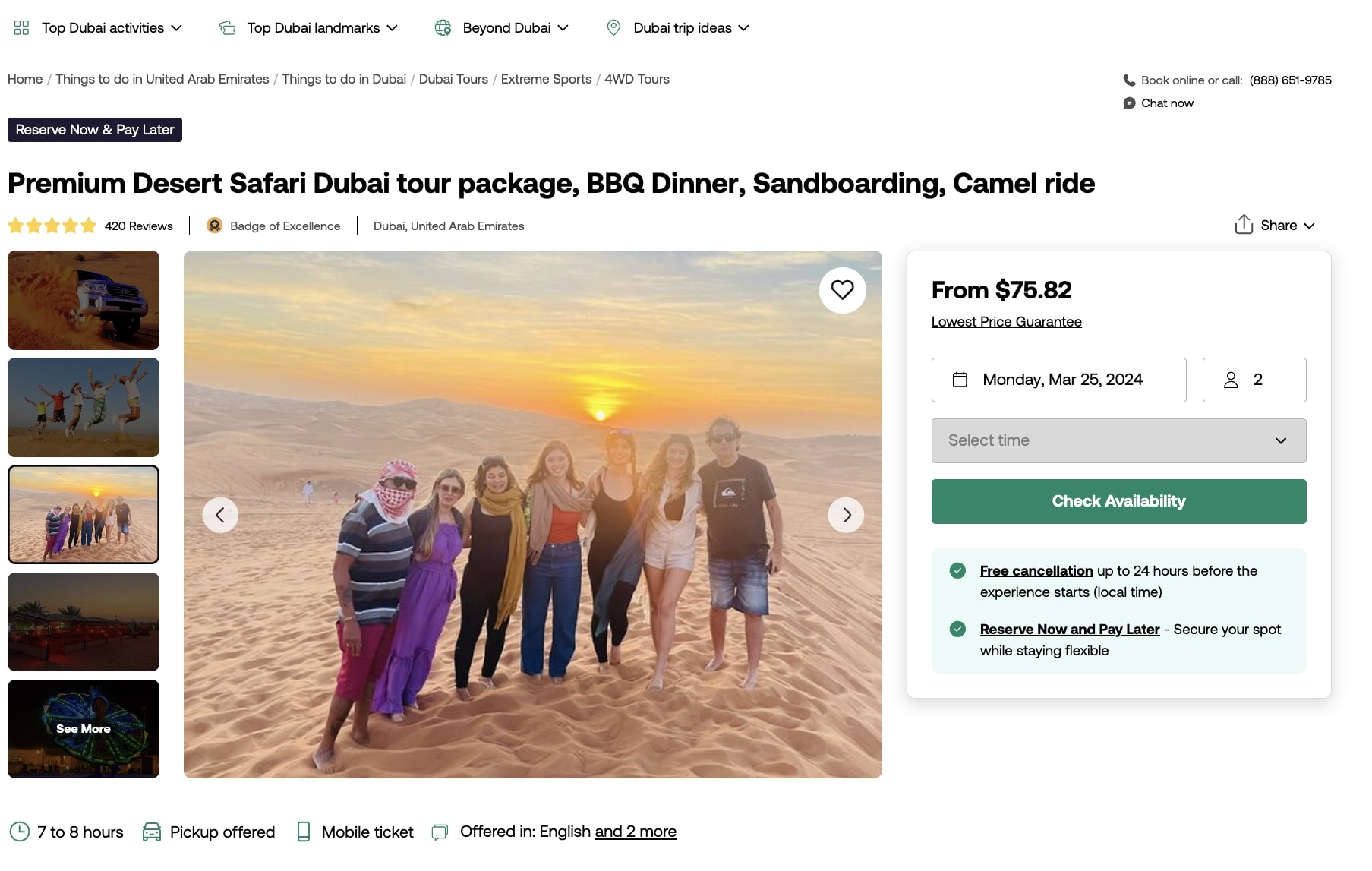
We can instantly see reviews and star ratings, pictures from past tours, availability, payment and cancellation policies, duration, pick-up information, pricing, and more.
Then, we can scroll below to see all the “fine print” and read more about the experience.
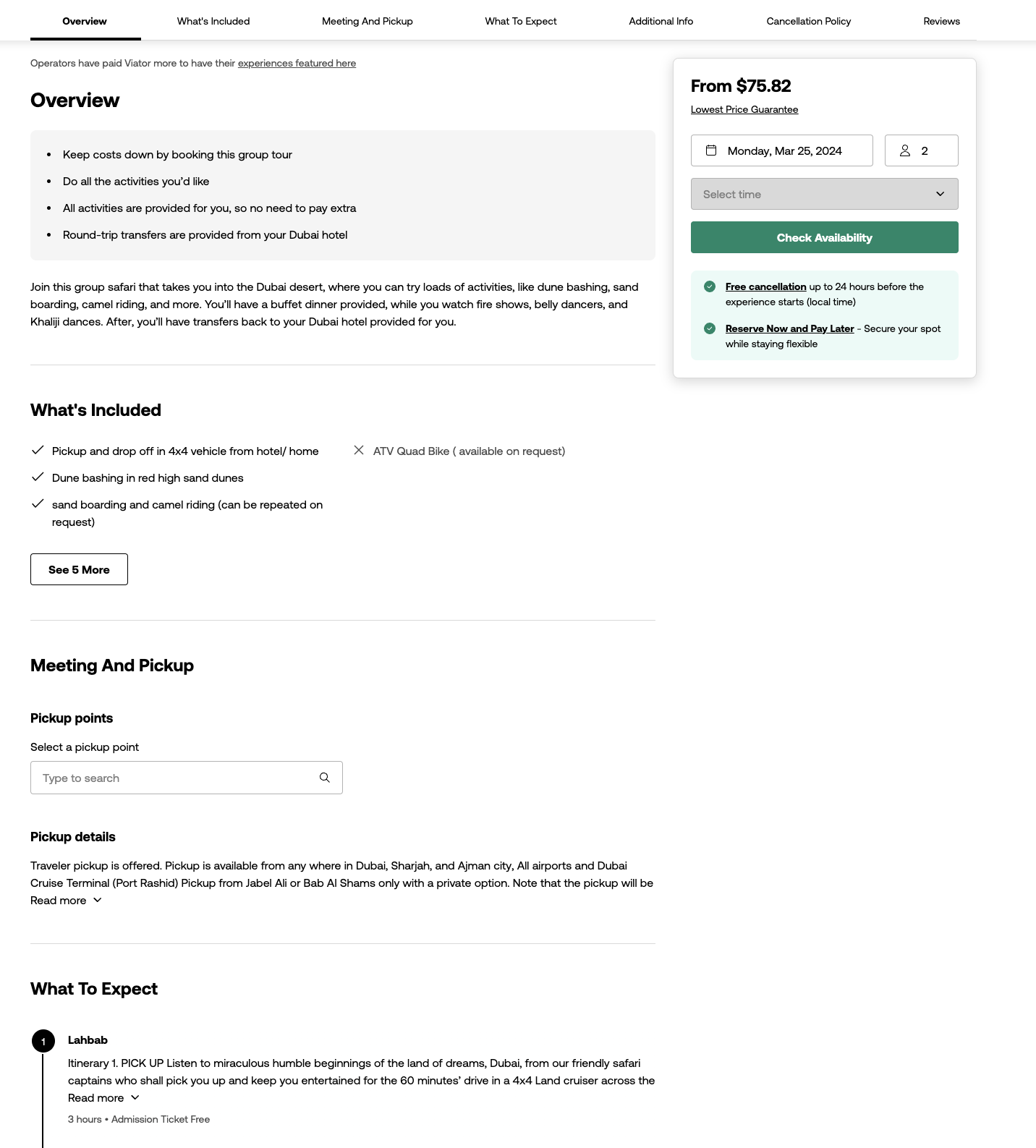
We have all the information we need to decide whether to book; we don’t have to contact the tour operator to ask about payments or cancellations, or to request or confirm bookings.
Create clear package names & detailed itineraries
Now, let’s get into the details on creating your listings.
First, you should give packages catchy but clear titles. They should give customers some “preview” of what your package provides.
However, be mindful of title length; you don’t want excessively long titles. You should also avoid unnecessary special characters (like asterisks, $, or ~) that look “spammy.”
Next, you’ll carefully create engaging, detailed tour listings. An important note here: You want to create dedicated listings for each experience within the package, and then you can combine them into one comprehensive product.
Here’s what you’ll outline for travellers:
- The duration of each experience
- Addresses and locations of experiences
- The full tour itinerary
- A thorough description of the tour or activity
- High-quality photos or videos from past experiences; listings should include at least six images. Use a variety of shots and media to showcase your experiences.
- Notable inclusions/exclusions
- Details about transportation to and from tours, including pick-up or drop-off points and check-in locations
- Notes on how to prepare for the experience and what to bring — any equipment, bathing suits, sunscreen, hats, shoe type (water, hiking, climbing), protective covers for phones, etc.
- Add-ons to purchase with experiences
The booking system you use should have product builders that guide you through each step, showing you what to include in your listings. For example, Bókun’s Experience tab, below, outlines all of this for you.
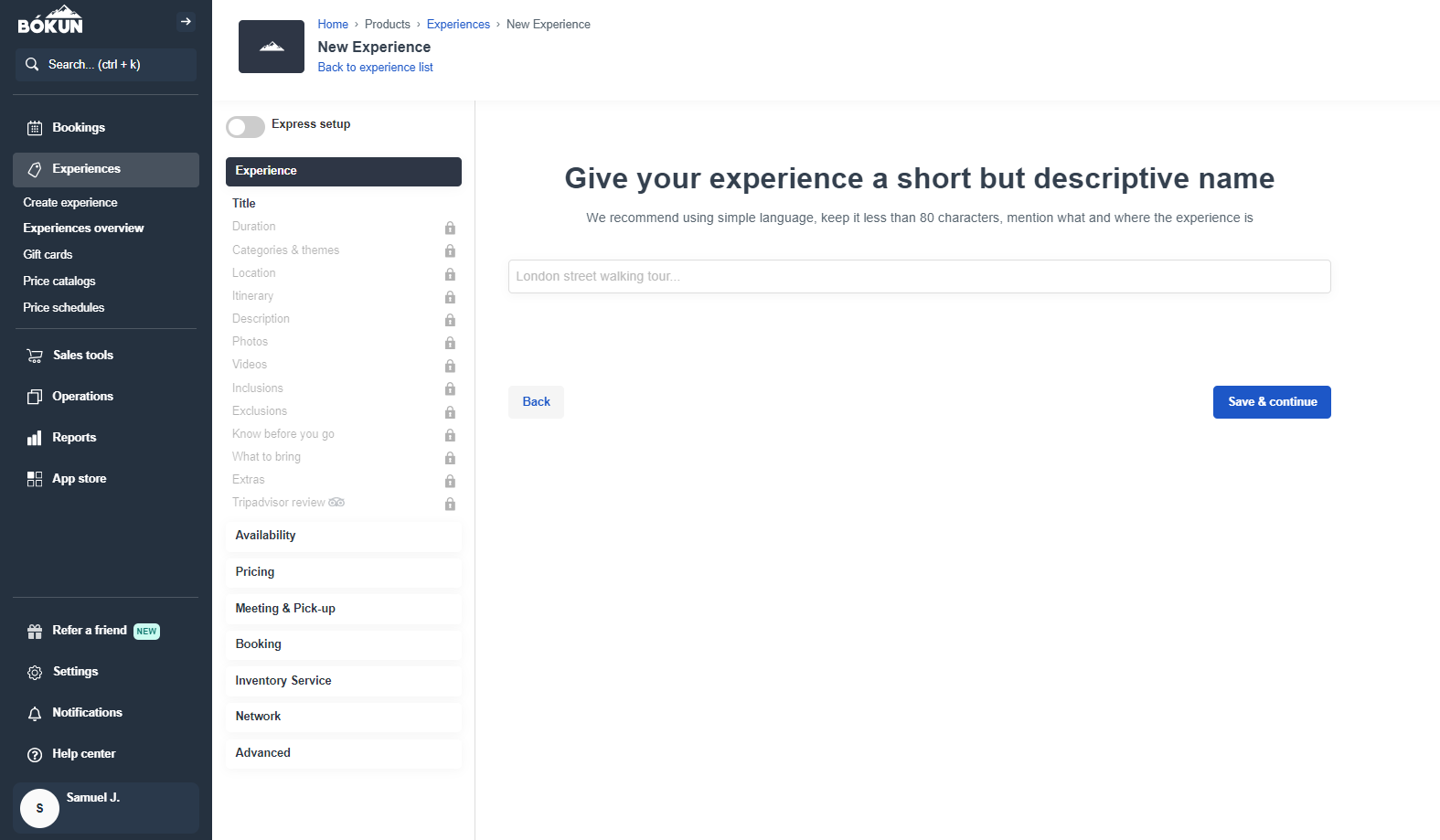
Set competitive pricing
Next, you’ll set pricing for your packages. As mentioned above, you should include the pricing for each experience as if it were a standalone product. Then, you can offer a discounted rate when combining products so customers can easily see what they’ll save by opting for a package.
There are a few ways you can do pricing:
- Create a flat rate for your package
- Offer rates for private experiences
- Enable bulk discounts for travellers booking group trips
- Set pricing categories so you can charge different rates for children, adults, and seniors
- Provide discounted pricing to active military personnel, veterans, and first responders
You can also take advantage of dynamic pricing if your booking system offers the feature. Bókun’s dynamic pricing will automatically optimise your rates based on rules you set. For example, you could set rules to adjust pricing…
- If the booking cutoff is approaching and you still have slots left
- During different times of the year
- For early bookers
- Across different OTA sites
- For groups
Source partners to create tour packages
Working with partners is highly beneficial when creating tour packages because it allows you to offer more (diversity, convenience) to potential customers.
You can offer different types of tours — for example, provide experiences you usually couldn’t or visit places you don’t typically have access to — and create multi-day, comprehensive travel packages with full accommodations for customers.
Travel packages can include a combination of:
- Tours and activities
- Accommodations (like hotel or resort stays)
- Transportation services (planes, trains, buses, local transport)
- Meals and dining experiences (restaurant reservations, food tours, picnic lunches)
- Equipment rentals (bikes, snorkel gear, ski equipment, photography equipment)
- Tickets and passes (attraction entries, museum passes, event tickets)
There are two common ways to establish partnerships:
- You can reach out to businesses directly (usually over email) and suggest a collaboration. However, this approach is time-consuming and cold emails are frequently ignored or mistaken for spam.
- You can connect with other travel businesses through your booking software’s distribution network. This is the most recommended method because your booking software brand has vetted these providers, and you’re already part of the same distribution ecosystem. Additionally, these platforms often handle contract and payment logistics, making collaboration significantly simpler.
Note: If you’re not already using a booking system to sell tours online and manage reservations from OTAs, you should consider this upgrade to create and sell tour packages effectively. Otherwise, you’ll have trouble sourcing partners, managing reservations from partners, attributing bookings and commissions, listing travel packages on websites & more.
Learn more about these solutions here: Top-rated activity booking software
Our tour operator software, Bókun, offers a partner network (Marketplace) with over 27K businesses in the tourism and travel industry. These include travel agents, destination management companies, resorts, hostels, hotel chains, attractions, rental providers, transportation services, other tour operators, and activity-based businesses.
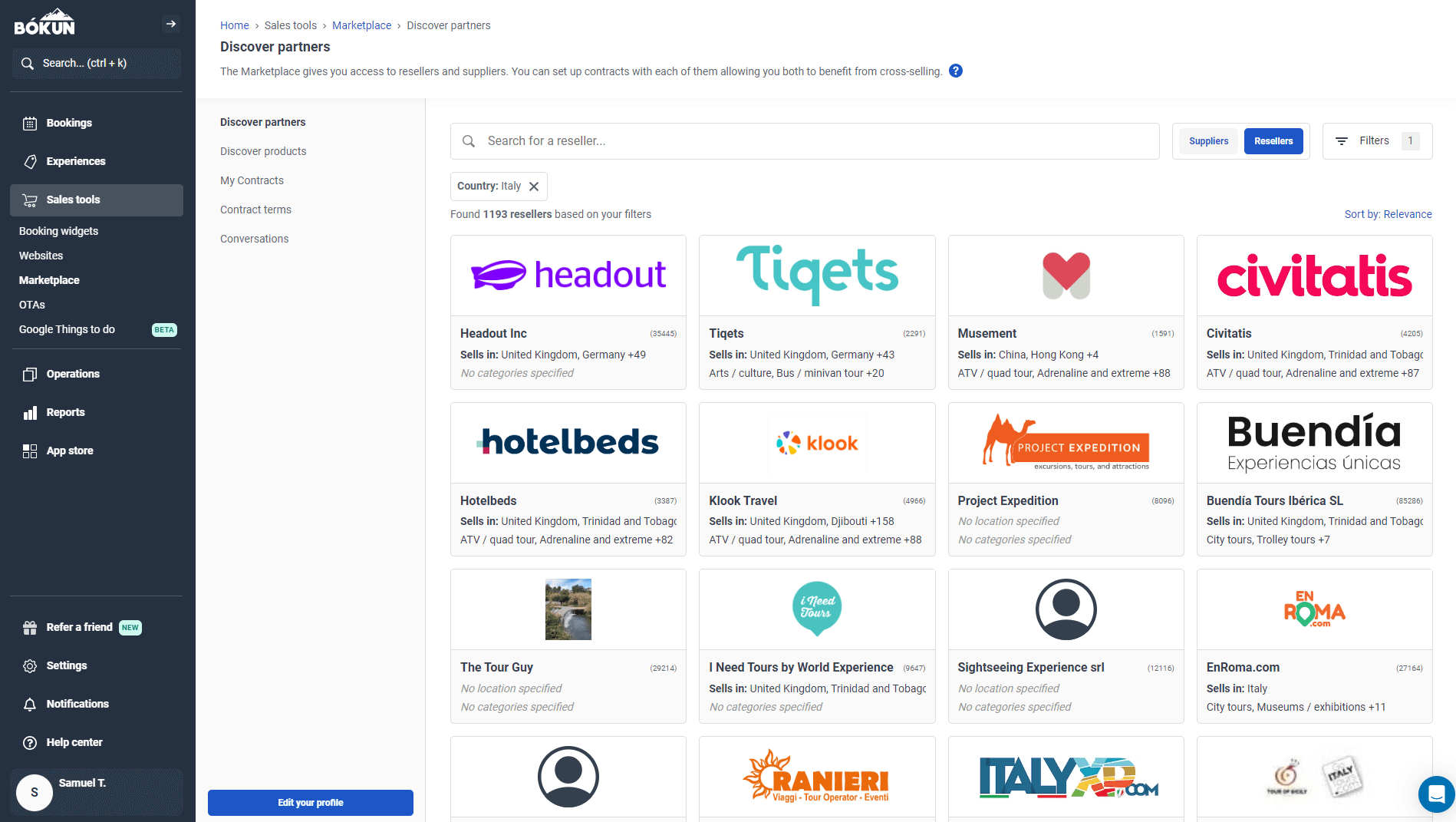
Virtually every client can find partners offering complementary services and experiences here.
There are a few ways to use our Marketplace — first (and most obviously), you can connect with partners to offer tour packages.
For example, say you run walking tours, you could partner with a boat charter company to create a “City by Land and Sea” package that shows your destination from two perspectives. Or team up with a food tour guide to offer a “History and Flavours” experience combining culture with cuisine.
Those operating bike tours could partner with a wine tour operator for a “Vineyard Cycling Adventure” or work with a brewery tour company for a “Pedal and Pints” package.
If you offer workshops such as pottery or painting classes, you could partner with a sightseeing guide to create a “Culture and Crafts” package — starting with a historic district tour and concluding with a hands-on workshop where travellers create their own souvenirs.
Alternatively, you could partner with:
- A hotel or resort to offer multi-day packages. For example, you could work with a ski resort to bundle your snowshoe tours with their weekend lodging, or a beachfront hotel to include your snorkelling excursions in an “Island Adventure” package.
- Transportation services, such as shuttles or rental car providers, to eliminate the logistics headache for travellers. You could include airport transfers in your multi-day package or partner with a shuttle service to provide hotel pickups for your tours, so customers don’t have to worry about finding their way to the meeting point.
- Travel agents, who can market your tours to their clients planning trips to your destination, essentially operating as another salesperson for your travel experiences.
In addition to creating packages with partners, you can function as a supplier (where others sell your tours for a commission) or reseller (where you resell others’ experiences or services for a commission).
Our system has all the necessary features to research partners, establish connections, and manage contracts. You can communicate within Bókun to decide on package details, create and send contracts, and reference all communications and documents.
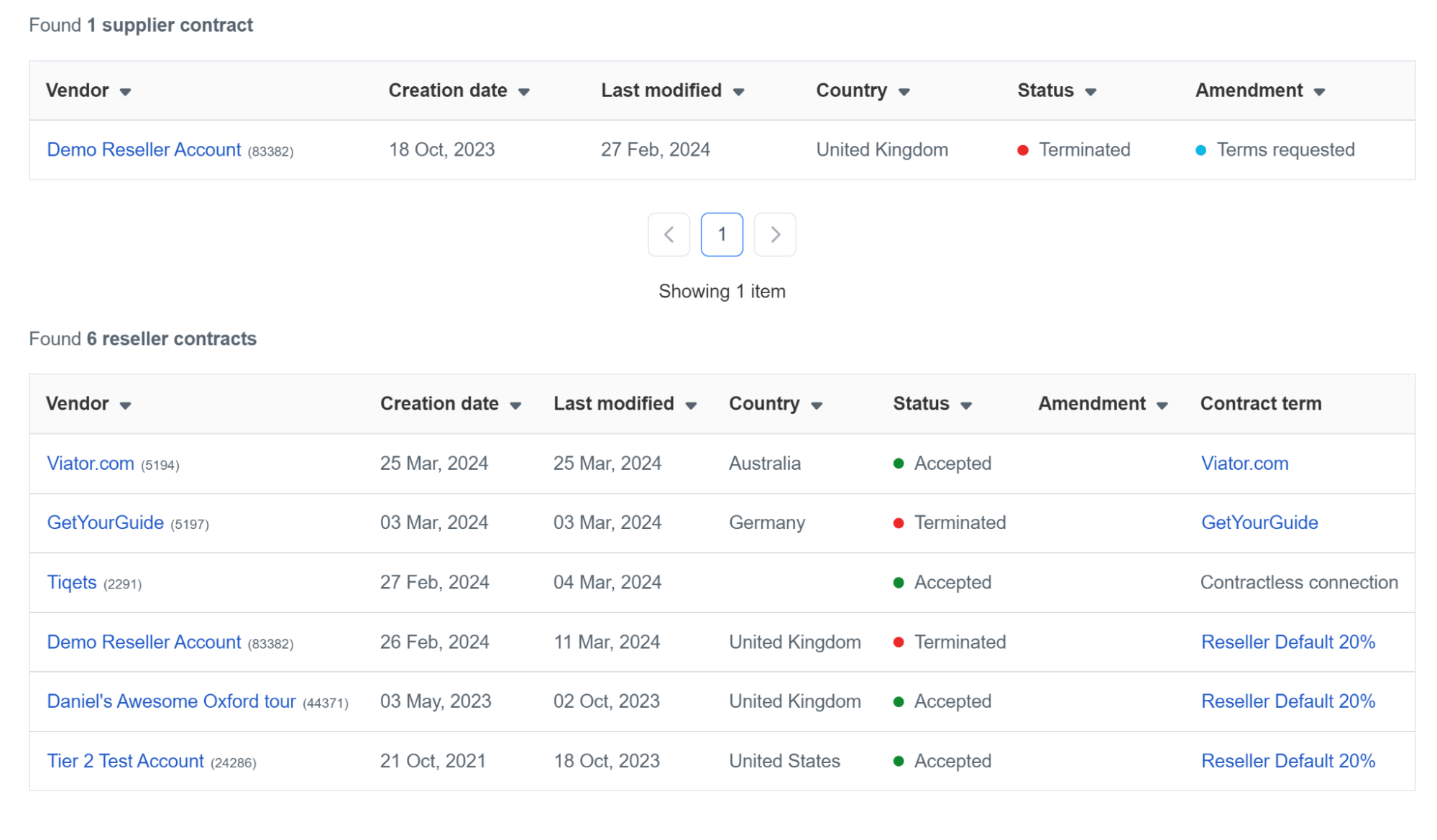
You can work with an unlimited number of partners and modify these contracts at any time. At the time of writing, our system holds over 150,000 contracts between suppliers and resellers.
On average, $1M worth of bookings flow through our Marketplace every day.
Read more: Discover partnership opportunities in the marketplace
5 tips to market your tour packages
Once you’ve created your tour packages, it’s time to showcase them to potential customers.
Here are five proven strategies to promote your packages and drive bookings:
1. Email marketing
Email remains one of the most effective ways to market tour packages — though primarily to past customers who already trust your business. You can send announcements about new packages, seasonal offerings, or limited-time deals.
You should also segment your audience based on previous bookings — families might be interested in family-friendly packages, while couples could receive promotions for romantic getaways.
2. Social media marketing
Showcase your packages through photos and videos, highlighting what makes your experiences unique. Create carousels showing day-by-day breakdowns, or short video clips that give viewers a taste of the experience.
To expand your reach beyond your followers, you can:
- Partner with travel influencers or local content creators whose audiences match your target customers.
- Ask customers to post about their experiences and tag your brand (you can even throw them a discount or freebie for doing so).
- Leverage hashtags and trends to jump in on what’s popular.
Bókun also offers Referral Tracking to assist here. Partner with any business or professional of your choosing — social media influencers, bloggers, other local businesses — and they can promote your tours and packages to their audiences. Our system provides them with dedicated booking links, allowing them to secure new reservations for you easily. You receive new customers, and affiliates earn commissions.
3. Website SEO
Create dedicated pages for each package with detailed descriptions, itineraries, pricing, and high-quality images. Use relevant keywords, such as “tour packages in Rome” or “family-friendly Iceland vacation,” in your page titles and content to improve search engine performance.
You can also take things a step further and write blog posts that naturally link to your packages. For example, a post on “Best Things to Do in [Your City Here] in 3 Days” could showcase your tour package as a suggestion.
Don’t forget to drop booking links in content to encourage conversions!
4. Leverage your partners’ marketing channels
Coordinate with partners to cross-promote packages on their websites, email newsletters, and social media. We suggest providing them with ready-to-use marketing materials — photos, copy, booking links — to make promotion easy.
5. Encourage customer reviews
During tour experiences, ask your customers to leave reviews on Tripadvisor, Viator, Google, or your website. You can also send review request emails after customers visit, as a little nudge, so they don’t forget.
We also wrote a guide here with tips to earn more customer reviews.
A key tip for all promotional content: Always remember to emphasise the value that packages offer, such as bundled pricing, curated experiences, the convenience of including everything planned, seamless coordination, and a single booking. These are the primary reasons travellers book packages.
Read more in our guides below:
- How to market your tour experiences (free & paid strategies)
- 8 ways to increase direct website bookings
- Tour operator SEO strategy guide
Best practices for managing tour packages
First, don’t forget about timing.
You want to avoid overlap between experiences and give customers time between tours (for breaks or to travel to the next destination).
For example, three experiences right after each other could be overwhelming for customers. But you could package two morning experiences to fill customers’ AMs and then offer a sunset sailing tour in the evening. Or, you could package sightseeing tours in the afternoon and a food tour in the evening.
Remember that many customers book packages for convenience; consider the customer experience and what would be most convenient for them during their visit.
Next, be choosy with partner selection, and don’t forget about legalities.
You don’t want to go into business with somebody you wouldn’t confidently endorse or refer to customers; even if you follow through on your end of the deal, your partners could provide a less-than-stellar experience. This could negatively impact how they view you (guilty by association) and lead to poor reviews.
You may want to consult with lawyers to learn more about the technicalities and language used in developing the terms and conditions of partner contracts.
Again, it’s best practice to manage tour packages, bookings, and partnerships in dedicated booking management software.
These systems become necessary as you scale, sell tours on OTAs, and explore other growth opportunities — such as creating tour packages — because they keep back-end operations organised. They also help you avoid blunders like overbookings, missed bookings, and missed payments (i.e., forgetting to charge customers), among others.
We won’t delve into all of that in this post; you can read more about tour operator software in our comprehensive guide.
How to create tour packages in Bókun
We’ve explained throughout how our platform simplifies this process, but we’ll summarise the main points here as a quick overview.
For starters, our tour operator software lets you:
- Manage all of your tour offerings and packages with ease
- Design detailed listings (and even save templates to speed up this process in the future)
- Build combo packages from your product line or in collaboration with partners
- Set pricing for tours and utilise dynamic pricing
- Create availability rules by product
- Track resources like supplies, equipment, and staff for tours and assign allocation rules to optimise utilisation
- Sell tour experiences on your website, OTAs, partner sites, and through affiliates
- Enable fast and simple online payments
- Centralise bookings from all sales channels and keep an up-to-date calendar
- Automate back-office operations like managing your customer contact list and dispatching email communications
Bókun has tools to:
- Guide you through the process of building tour listings and packages: Our product builder walks you through step by step and shows you all the details to include when designing listings.
- Connect with partners: As explained above, our Marketplace contains over 27K+ businesses, allowing you to partner with a variety of travel industry businesses to bundle your experiences and offer unique packages for customers.
- Create combo experiences: Simply choose a tour you want to bundle and enable the toggle “This experience is a combination of other experiences” > “Continue.”
Bókun even has safeguards to help implement the best practices we discussed above. For example, it won’t let you combine experiences that overlap or aren’t in the same area (or are too far for customers to travel between).
Our system automatically publishes experiences to your website and partner sites, allowing you to receive online bookings in various ways. If you add these tour packages to (connected) OTAs, the bookings from those platforms will also appear in Bókun.
Using booking software to promote and sell your travel products offers a hassle-free booking process for customers, helping you earn new business and enhance the overall customer experience. Customers can:
- Find your packages on various websites — the OTAs they already use to research travel and book tours, or on your website or partner sites
- See your products and tour packages, and your (real-time) availability
- Choose their desired product and time slot
- Confirm their booking, pay online, and complete the checkout process
- View upcoming reservations and modify or cancel bookings at their convenience
Our system also enables you to send digital tickets and waivers, streamlining the customer check-in process.
A brief demo video
We also put together a brief two-minute demo video on this topic:
Getting started
Bókun was born in Iceland and raised by Tripadvisor, offering a vast network of resources and years of experience helping our customers run successful tour companies, achieve new milestones, reach global audiences, and drive continued growth.
Our long industry history has allowed us to secure a variety of exclusive integrations and partnerships (with Viator, GetYourGuide, Google Things to do, and Airbnb) to help our customers see the most success when selling tours and travel packages online.
We’re consistently voted one of the top-rated tour operator software — with a long-standing 4.7-star rating — for our platform’s:
- All-in-one toolkit, allowing you to manage all areas of operations under one roof.
- Ease of use. Anyone can jump on board, learn our system (without any formal training), and leverage all its benefits.
- Value for money, with straightforward plans and the industry’s lowest booking fees. The majority of customers succeed with our START plan at $49/month, with 1.5% online booking fees.
- Scalability, because Bókun grows with you and doesn’t limit your products, sales channels, partners, or customer reach.
- Our hands-on support team. We’re always here to answer questions when you need us. We also provide yearly strategy calls with our enterprise users, ensuring Bókun is always optimised for their evolving needs.
Start a free 14-day trial (no credit card required!) to see how Bókun can support your growth.
Related reads:

